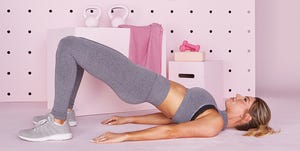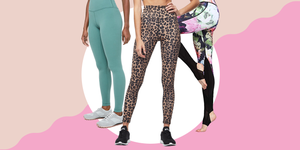The Secret To Seeing Better Results From Your Barre Class
When I first heard the term “barre class” a couple years ago, I was immediately transported back to my days as a baby ballerina, when time at the barre meant pliés, stretches that made my hamstrings feel like they were on fire, and a whole lot of fancy footwork.
My ballet career was short, to say the least. (I tossed my ballet shoes after age seven.) So I was skeptical about a whole fitness class centered around, what I remembered as, the worst part of ballet lessons. (Just being honest here.)
Fast-forward to my first session at Pure Barre—a fitness studio built entirely around the barre—after my roommate at the time assured me it was an amazing workout. I was reluctant at first, but I left the class feeling like every tiny muscle in my core, butt, arms, and legs had been put to the test. I was completely sore the next day.
And while it was reminiscent of my ballet days of yore, it actually felt a lot more like a Pilates or sculpting workout. The class focused on cardio, strength training, and stretching, rather than perfect dance technique. Since that day, I’ve tried out barre studios across New York City—Physique 57, Xtend, Flybarre, Barre Method, Exhale–and I’ve always been impressed by how much each class challenges my entire body.
To give you a better idea of what to expect in your first barre class, I chatted with Katelyn DiGiorgio, the VP of training and technique at Pure Barre, for the lowdown.
What is barre, exactly?
“Barre class is a workout technique inspired by elements of ballet, yoga, and Pilates, that focuses on low-impact, high intensity movements designed to strengthen and tone your body in ways that few other workouts can,” says DiGiorgio.
View this post on Instagram
A post shared by Pure Barre (@pure_barre) on
What kind of workout should you expect?
Each class is designed to be a full-body workout (as I’ve definitely experienced), broken into different sections that focus on major muscle groups including the arms, thighs, glutes, and core.



“The muscles in each group are fatigued via small targeted movements, high repetition, and light weight or resistance,” says DiGiorgio. Think: pulsing in a squat to target the glutes and quads, cranking out as many triceps kickbacks as possible with three pound weights, or moving through a lively plank sequence. “Sections of class are also paired with stretching to increase overall flexibility,” she explains. So if you struggle with flexibility (*raises hand*) this class is a great choice, too.
DiGiorgio says the class is also designed to boost endurance, improve balance, increase range of motion, promote better posture, and help with weight management.
Is barre class just for dancers?
As I noted, I am far from a capable dancer (any of my friends will attest to this), and DiGiorgio agrees that barre is for everyone. “The community is made of people who have tried every group fitness class ever created, as well as those just starting their fitness journey.”
That said, as with any type of fitness, don’t expect to master it after one go. “Class moves quickly, and can be challenging, since you’ll utilize muscles you never knew you had,” says DiGiorgio. “But you’ll get the hang of it after 3 to 4 classes, and can generally see results in just 8 to 10 classes.”
Any form tips?
In your first class, “one of the more challenging form essentials to grasp is the idea of small, controlled movements,” says DiGiorgio. “When you hear your teacher say pulse, for example, that literally means just move an inch up and down.” You’re focusing on contracting the target muscle, which means your range of motion will be controlled and precise.
View this post on Instagram
A post shared by Pure Barre (@pure_barre) on
While all barre studios are slightly different, you’ll likely be instructed to “tuck your tailbone” or have a “heavy tailbone” at some point during class. To do that, you need to draw your abs inward as you roll your hips under slightly to create a neutral spine, says DiGiorgio. You’ll often assume this position during class, which also promotes core engagement and toning.
Is this workout right for you?
What are your fitness goals? “If you want to improve your posture, increase core strength, become more flexible, improve muscle tone, or just break up the monotony of your normal gym routine, you should definitely give barre a try,” says DiGiorgio.
And, again, this is a great workout for anyone. “Unlike many exercise programs which require a high level of physical fitness or prior expertise, barre is very beginner friendly, and adaptable to different skill sets and ability levels,” she says.
What kind of clothes should you wear to class?



While workout outfits are totally based on personal preference, DiGiorgio recommends wearing leggings or capris that you feel comfortable in, and a workout tank or T-shirt. Wearing clothes that sit close to your body helps your instructor get a better view of your form throughout class, and give you advice on necessary adjustments. You’ll also want to wear sticky socks to prevent your feet from sliding. (Trust me, this one is essential.)
Here are a few great grippy barre socks to get you started:
Bottom line: Barre class is great for anyone—whether you’re new to fitness or you’ve danced ballet your whole life. Prepare for a total-body workout.
Source: Read Full Article
